Top 8 Incredible Natural Arches and Bridges in China
Natural arches, also called natural bridges as they resemble bridges, are some of the most incredible geological formations on the planet, and show the uncanny power of Mother Nature. They typically form after the collapse of the lower softer stone layer under the hard cap rock due to erosion from water or weather. They can be found in many parts of the world. And in China, you have many chances to admire these majestic and beautiful natural wonders.
1. Tianmen Mountain
Location: Tianmen Mountian National Park, 8km from Zhangjiajie City, Hunan Province
Tianmen Mountian, literally meaning Heaven's Gate Mountain, is the highest mountain in this area, with a height of 1518.6 meters (4,982 feet). What makes this mountain famous is the marvelous natural miracle called Tianmen Cave.
Tianmen Cave is a formally mountain-penetrating karst cave formed naturally as a result of water erosion no later than 48 A.D., according to research. In the year 263, the back of the cave collapsed, forming the arch, like a gate to heaven. Heaven seems visible through this gate hanging on the towering cliff, thus the mountain's name was changed.
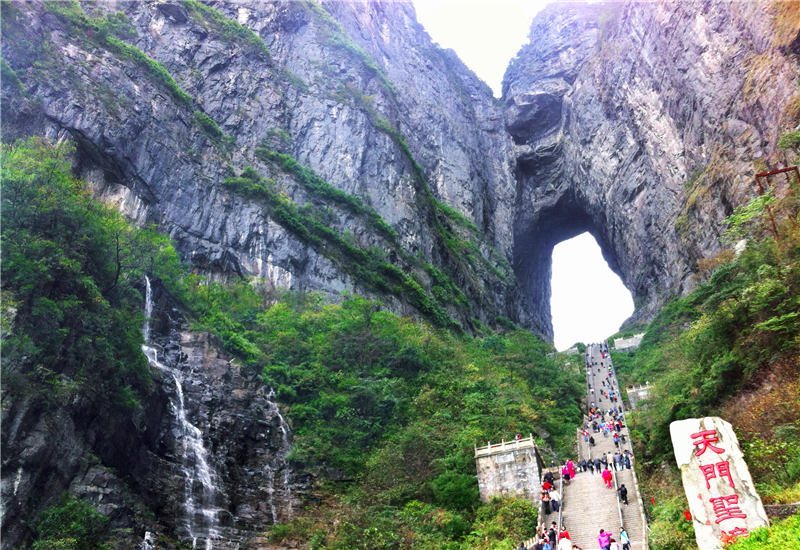 The majestic Heaven's Gate Mountain
The majestic Heaven's Gate Mountain
The arch is 131.5 meters (431.4 feet) in height, 57 meters (187 feet) in width, and 60 meters (197 feet) in depth, and at an altitude of 1,300 meters (4,265 feet), regarded as the highest naturally formed arch in the world.
To reach to the fantastic gate-like cave, you need to walk up 999 steps on the "stairway to heaven". The number "9" here is not accidental. It is a lucky number in Chinese numerology, representing good fortune and eternity. The cave is usually capped with clouds, giving a feeling that you'll find yourself in heaven after you pass through the gate.
Besides the impressive Tianmen Cave, you can also visit the ancient Tianmenshan Temple and walk the cliff-hanging walkways to enjoy incredible views.
2. Rocky Natural Bridge (the First Bridge under the Sun)
Location: Wulingyuan, Zhangjiajie World Geological Park, Zhangjiajie City, Hunan Province
In Wulingyuan, a scenic area less than 50km from the Tianmen Mountain, there is a natural rock bridge known as the First Bridge under the Sun. It is 2 meters (6.6 feet) wide, 5 meters (16 feet) deep, and has a span of 50 meters (164 feet) and a relative height of about 400 meters (1,312 feet). It was formed after the lower rock collapsed because of weather erosion. There is a pathway on the top of the bridge, through which you can reach the peak on the other side.
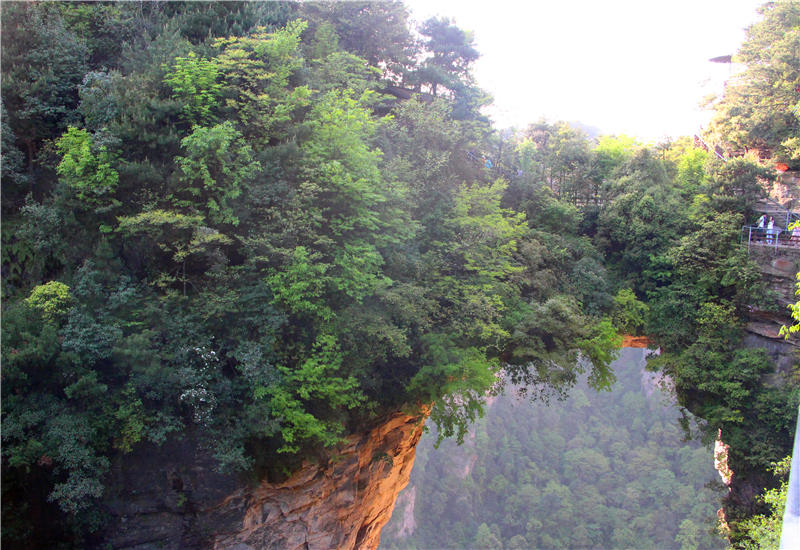 Situated very high between two mountain peaks, it looks so charming and dangerous.
Situated very high between two mountain peaks, it looks so charming and dangerous.
3. The Three Natural Bridges
Location: 12km from Wulong County, Chongqing Municipality
The Three Natural Bridges, as its name suggests, is composed of three natural limestone arch bridges standing within Wulong Karst National Geology Park, which is a part of a UNESCO World Heritage Site. These stunning bridges are Tianlong Bridge (literally Sky Dragon Bridge), Qinglong Bridge (Azure Dragon Bridge) and Heilong Bridge (Black Dragon) respectively, constituting the largest natural arch bridge cluster in Asia.
Tianlong Bridge is 235 meters (771 feet) in height, 150 meters (490 feet) in thickness, and 147 meters (482 feet) in width. It actually has two arches with a height of 84-123 meters (275-403 feet) and a span of 20-75 meters (66-246 feet).
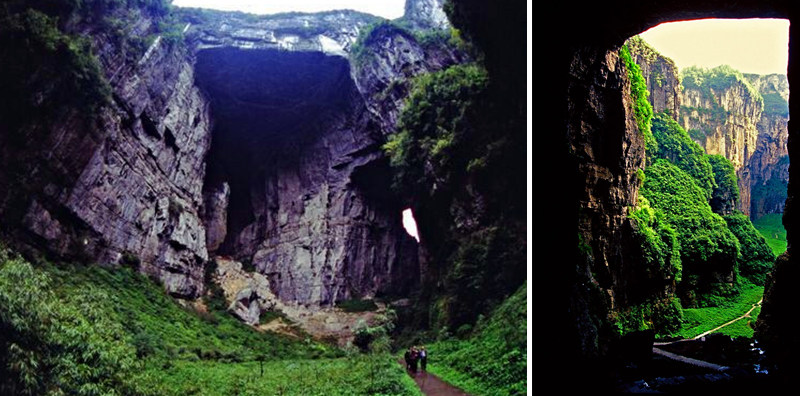 The Tianlong Bridge
The Tianlong Bridge
Qinglong Bridge is 281 meters (922 feet) in height, 168 meters (551 feet) in thickness, and 124 meters (406 feet) in width; and the arch is 96-110 meters (315-361 feet) in height and 13-58 meters (43-190 feet) in span. It is the highest natural karst bridges in China.
Heilong Bridge is 223 meters (732 feet) in height, 107 meters (351 feet) in thickness, and 193 meters (633 feet) in width; and the arch is 90-141 meters (295-463 feet) in height and 16-49 meters (52-161 feet) in span.
Between the bridges lie two natural sinkholes (tiankeng in Chinese), namely Qinglong Tiankeng and Shenying Tiankeng, which is 276–285 meters (906-935 feet) in depth and 300-522 meters (984-1713 feet) in circumference.
From the numbers above, you may imagine the majestic and marvelous spectacle. How was it formed? It is actually the creation of Mother Nature by means of tectonic uplift and underground water erosion. The uplifted parts formed the bridges, and the collapsed parts formed the sinkholes (karst pits).
This geological wonder was one of the filming locations of the films Transformers: Age of Extinction and Curse of the Golden Flower. Yet, it is still unfamiliar to the world, so you can admire the unspoiled beauty there. The best time to visit is spring and autumn.
4. Elephant Trunk Hill
Location: Downtown Guilin City, Guangxi Zhuang Autonomous Region
Standing on the western bank of Li River, the Elephant Trunk Hill is a karstic hill formation formed from pure limestone about 360 million years ago. It is a symbol of its karst landscape and the most recognized symbol of Guilin City. This hill is so named because it looks like an elephant drinking water from the river with its trunk.
The Water Moon Cave located under the elephant's trunk and leg is a natural semi-round arch penetrated by water. It is said that it was formed by water erosion 12,000 years ago, when the earth's crust lifted and the Li River shrunk. This natural wonder is 17 meters (56 feet) long, 9.5 meters (31 feet) wide, 12 meters (39 feet) high. It looks like a bright full moon floating on the surface of the water, hence its name.
When visiting the cave, you will be welcomed by various poems and paintings inscribed on the walls applauding the beauty of the hill and waters nearby, which can date back to the Tang Dynasty (618-907).
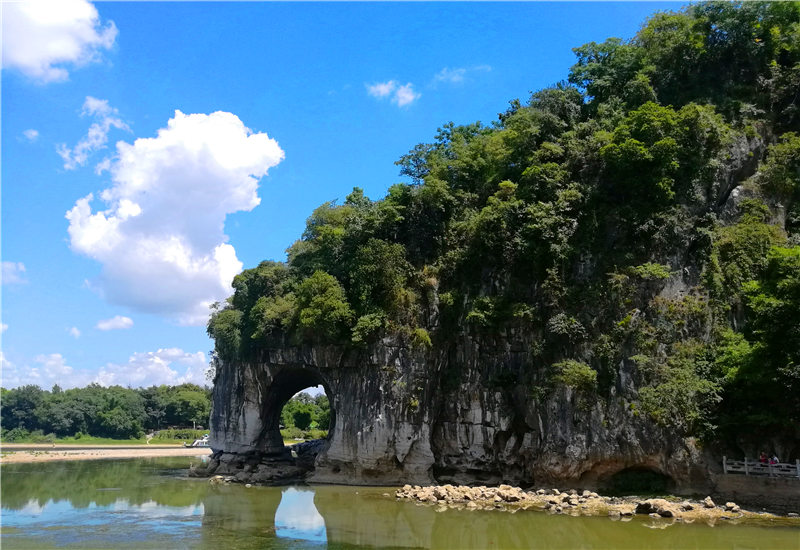 A close view of the Elephant Trunk Hill
A close view of the Elephant Trunk Hill
5. Moon Hill
Location: 8 km outside Yangshuo County, Guilin City, Guangxi Zhuang Autonomous Region
In Moon Hill, there is a natural arch penetrating the hill from north to south. The arch is actually a wide semicircular hole, formed from the remnant of a karst limestone cave. The arch is about 50 meters (164 feet) high, 50 meters (164 feet) wide, and 5 meters deep (16 feet), hanging almost on the top of the 230 meters (755 feet ) high hill.
The arch resembles a bright moon, thus the hill is named Moon Hill. Seen from different directions, the "moon" can be enjoyed in different shapes, from a new moon to an old moon and then to a full moon. On a nice day, the blue sky, snow-white clouds and picturesque rural landscape make a wonderful background against the "moon". On clear evenings at the Moon, you can even possibly see the real Moon through the arch of the hill.
To reach the "moon palace", you need to climb up about 800 steps. It usually takes around 20 minutes. In the "palace", you will find various unique stalactites hanging from the ceiling. The bird-eye view of the surroundings from the arch is really breathtaking.
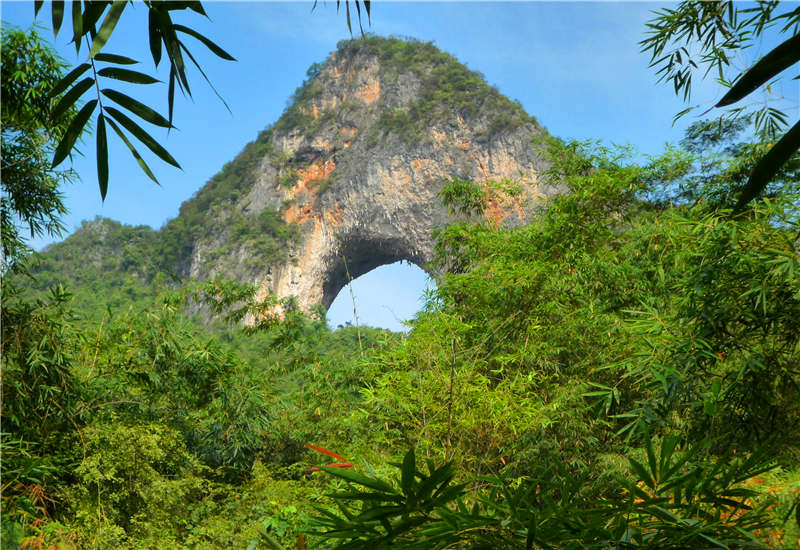 The unique moon hill seen from a lower angle
The unique moon hill seen from a lower angle
6. Xianren Bridge
Location: 51 km from Leye County, Baise City, Guangxi
Xianren Bridge, literally Fairy Bridge, is the world's longest natural arch, with a span of 121.9 ± 4.6 meters (400 ± 15 feet) measured by the Natural Arch and Bridge Society in October 2010. It was carved through limestone karst by flowing water in the Buliu River.
Xianren Bridge wasn't discovered until 2009, when Jay Wilbur, the founder of the Natural Arch and Bridge Society (NABS), spotted the massive natural bridge spanning a river while browsing Google Earth. Ray Millar, a member of NABS, attempted to reach the bridge in 2009, but failed. In 2010, he, together with six other NABS members, was successful with the help of our company as the tour operator of that trip.
Because of its remote location, it is accessible only by bamboo or inflatable rafts along the Buliu River. So this eye-popping site remains relatively unknown. Now it is a part of Leye-Fengshan Geopark.
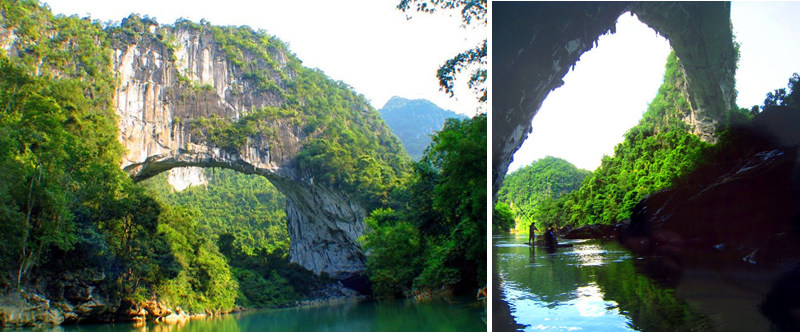 The Xianren bridge is really a valuable treasure that nature created.
The Xianren bridge is really a valuable treasure that nature created.
7. Jiangzhou Natural Bridge (Jianzhou Immortal Bridge)
Location: 26km southwest of Fengshan County, Hechi City, Guangxi
As a principal feature of the Leye-Fengshan Geopark, Jiangzhou Natural Bridge is a spectacular natural bridge resembling the ripping neck of a dinosaur kissing the east end of the mountain. It is the remains of karstic limestone after erosion.
The bridge is regarded as the second longest span in China, as the arch spans about 144 meters (472 feet) with a height of 46 meters (150 feet). The bridge is 166 meters (545 feet) in length, 94 meters (308 feet) in height and 38-42 meters (125-138 feet) in deck width and 18-24 meters (59-79 feet) in deck thickness.
 The climbing vines and hanging stalagmites add charm to the bridge.
The climbing vines and hanging stalagmites add charm to the bridge.
8. Mengli Natural Bridge
Location: 24 km northwest of Fengshan County, Hechi City, Guangxi
Located in the central area of the Leye-Fengshan Geopark, Mengli Natural Bridge is a natural bridge eroded through limestone by underground water. The arch is 60 meters (197 feet) in height and spans 60 meters (197 feet). The bridge deck is 17 meters (56 feet) in depth.
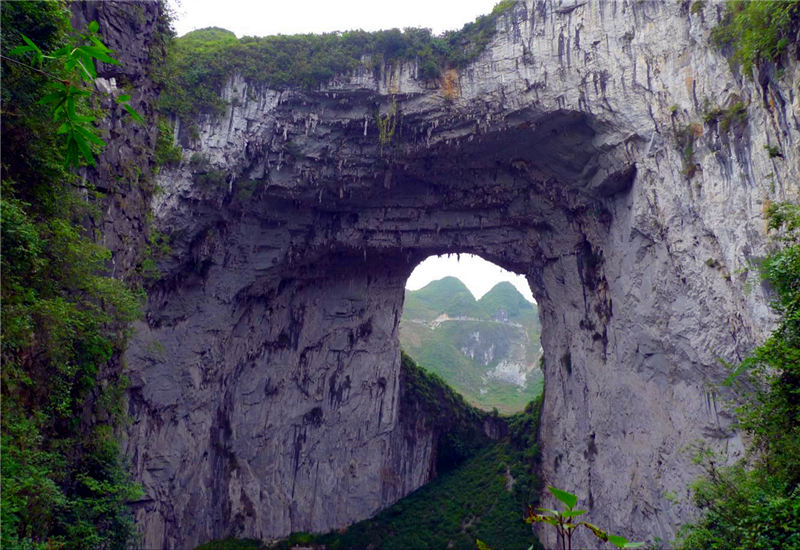 The excellent view of the bridge
The excellent view of the bridge
If you are planning to visit natural arches and bridges, the sooner the better, as all of them are still suffering from the erosion, and will constantly narrow until they inevitably collapse. So plan a tailor-made trip now to admire the beauty and power of Mother Nature.
Quick Question
What Our Clients Say
Explore the latest verified reviews of Odynovo's travel services on Tripadvisor, Google, Trustpilot, Product Review and more trusted platforms.
SUBSCRIBE TO WIN A FREE TOUR
Subscribe to our newsletter for a chance to win a free 7-day tour to India! And more insider travel news, exclusive offers, and inspiration will be sent straight to your inbox. Check our previous newsletters and get some sparks.

